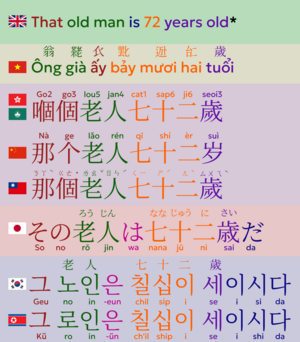Han unification is an effort by the authors of Unicode and the Universal Character Set to map multiple character sets of the Han characters of the so-called CJK languages into a single set of unified characters. Han characters are a feature shared in common by written Chinese (hanzi), Japanese (kanji), Korean (hanja) and Vietnamese.
In computing, Chinese character encodings can be used to represent text written in the CJK languages—Chinese, Japanese, Korean—and (rarely) obsolete Vietnamese, all of which use Chinese characters. Several general-purpose character encodings accommodate Chinese characters, and some of them were developed specifically for Chinese.

GB 18030 is a Chinese government standard, described as Information Technology — Chinese coded character set and defines the required language and character support necessary for software in China. GB18030 is the registered Internet name for the official character set of the People's Republic of China (PRC) superseding GB2312. As a Unicode Transformation Format, GB18030 supports both simplified and traditional Chinese characters. It is also compatible with legacy encodings including GB/T 2312, CP936, and GBK 1.0.
Extended Unix Code (EUC) is a multibyte character encoding system used primarily for Japanese, Korean, and simplified Chinese (characters).
GB/T 2312-1980 is a key official character set of the People's Republic of China, used for Simplified Chinese characters. GB2312 is the registered internet name for EUC-CN, which is its usual encoded form. GB refers to the Guobiao standards (国家标准), whereas the T suffix denotes a non-mandatory standard.

The Chinese Character Code for Information Interchange or CCCII is a character set developed by the Chinese Character Analysis Group in Taiwan. It was first published in 1980, and significantly expanded in 1982 and 1987.
The CNS 11643 character set, also officially known as the Chinese Standard Interchange Code or CSIC, is officially the standard character set of Taiwan. In practice, variants of the related Big5 character set are de facto standard.

Mojikyō, also known by its full name Konjaku Mojikyō, is a character encoding scheme. The Mojikyō Institute, which published the character set, also published computer software and TrueType fonts to accompany it. The Mojikyō Institute, chaired by Tadahisa Ishikawa (石川忠久), originally had its character set and related software and data redistributed on CD-ROMs sold in Kinokuniya stores.
む, in hiragana, or ム in katakana, is one of the Japanese kana, which each represent one mora. The hiragana is written with three strokes, while the katakana is written with two. Both represent.
A Unicode font is a computer font that maps glyphs to code points defined in the Unicode Standard. The vast majority of modern computer fonts use Unicode mappings, even those fonts which only include glyphs for a single writing system, or even only support the basic Latin alphabet. Fonts which support a wide range of Unicode scripts and Unicode symbols are sometimes referred to as "pan-Unicode fonts", although as the maximum number of glyphs that can be defined in a TrueType font is restricted to 65,535, it is not possible for a single font to provide individual glyphs for all defined Unicode characters. This article lists some widely used Unicode fonts that support a comparatively large number and broad range of Unicode characters.
The Chinese, Japanese and Korean (CJK) scripts share a common background, collectively known as CJK characters. During the process called Han unification, the common (shared) characters were identified and named CJK Unified Ideographs. As of Unicode 15.1, Unicode defines a total of 97,680 characters.

Radical 213 meaning "turtle" is one of only two of the 214 Kangxi radicals that are composed of 16 strokes.
JIS X 0212 is a Japanese Industrial Standard defining a coded character set for encoding supplementary characters for use in Japanese. This standard is intended to supplement JIS X 0208. It is numbered 953 or 5049 as an IBM code page.
KPS 9566 is a North Korean standard specifying a character encoding for the Chosŏn'gŭl (Hangul) writing system used for the Korean language. The edition of 1997 specified an ISO 2022-compliant 94×94 two-byte coded character set. Subsequent editions have added additional encoded characters outside of the 94×94 plane, in a manner comparable to UHC or GBK.
KS X 1001, "Code for Information Interchange ", formerly called KS C 5601, is a South Korean coded character set standard to represent Hangul and Hanja characters on a computer.
The CCITT Chinese Primary Set is a multi-byte graphic character set for Chinese communications created for the Consultative Committee on International Telephone and Telegraph (CCITT) in 1992. It is defined in ITU T.101, annex C, which codifies Data Syntax 2 Videotex. It is registered with the ISO-IR registry for use with ISO/IEC 2022 as ISO-IR-165, and encodable in the ISO-2022-CN-EXT code version.
The Vietnamese language is written with a Latin script with diacritics which requires several accommodations when typing on phone or computers. Software-based systems are a form of writing Vietnamese on phones or computers with software that can be installed on the device or from third-party software such as UniKey. Telex is the oldest input method devised to encode the Vietnamese language with its tones. Other input methods may also include VNI and VIQR. VNI input method is not to be confused with VNI code page.

Source Han Serif is a serif Song/Ming typeface created by Adobe and Google.
GB 12345, entitled Code of Chinese ideogram set for information interchange supplementary set, is a Traditional Chinese character set standard established by China, and can be thought as the traditional counterpart of GB 2312. It is used as an encoding of traditional Chinese characters, although it is not as commonly used as Big5. It has 6,866 characters, and has no relationship nor compatibility with Big5 and CNS 11643.
CJK Unified Ideographs Extension I is a Unicode block comprising CJK Unified Ideographs included in drafts of an amendment to China's GB 18030 standard circulated in 2022 and 2023, which were fast-tracked into Unicode in 2023.





